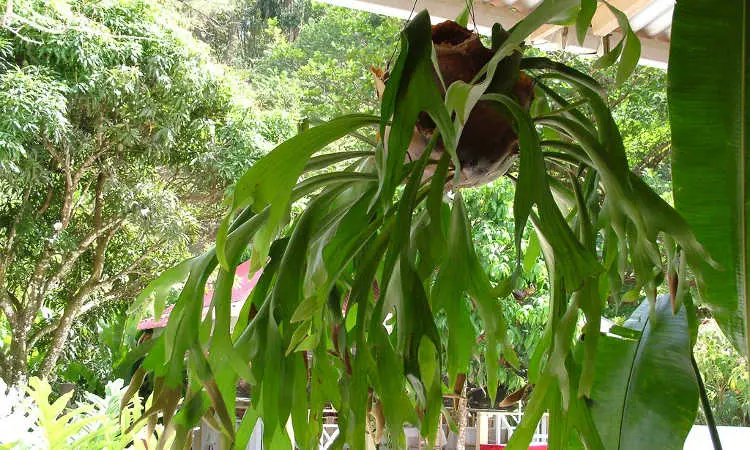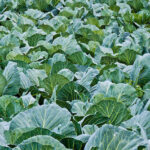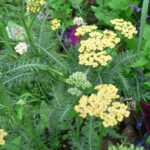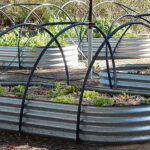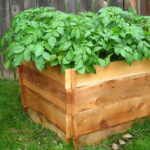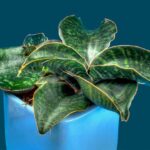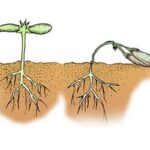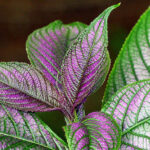An unusual tropical plant, the staghorn fern is often grown as a houseplant or hanging plant. Staghorn ferns have multiple kinds of leaves which serve different purposes, some of which are antler-like. And the shape gives this unusual plant its name, as if there were many green pairs of horns draping elegantly from the roots.
But what are staghorn ferns, and are they easy to care for? Today we’ll go over all of the ins and outs of growing staghorn ferns and reveal exactly how you can raise your own cluster of lush, green elkhorn fern leaves.
Quick Care Guide
| Common Name(s) | Staghorn fern, crown staghorn, elkhorn fern, disc stag’s horn fern, among many others. |
| Scientific Name | Platycerium species |
| Family | Polypodiaceae |
| Height | Up to 3-4 feet in width over time |
| Light | Bright indirect light |
| Water | Water sparingly, increasing frequency during hot/dry periods |
| Soil | Secure to board, use peat or sphagnum moss, coconut coir, or an extremely well-draining potting soil |
| Fertilizer | Monthly applications of a diluted balanced fertilizer during spring and summer. Every other month through fall/winter. |
| Pests and Diseases | Aphids and scale insects, especially mealybugs. Also susceptible to rhizoctonia leaf spot. |
All About the Staghorn Fern
This fern is unusual in that each plant has two different types of leaves. The uppermost leaves, called “shields” or basal fronds will catch fallen leaves, insects, and other debris to utilize for nutrients while shielding the roots from excess water.
The lower leaves produce spores from which most types of staghorn ferns propagate. Some varieties of staghorn ferns also make pups or offshoots, and over time can grow to encircle whatever surface they’re growing on. They’re popular in botanical gardens and as hanging plants in homes.
Staghorn ferns, also known as crown staghorn, elkhorn fern, disc stag’s horn fern, among many others) are epiphytic tropical plants that originate in South America, Africa, Southeast Asia, Australia, and New Guinea. It’s there the staghorn fern grows on a tree trunk in the forests there.
Types of Staghorn Fern
For most gardeners’ purposes there’s around eighteen varieties of staghorn fern grown commonly. Here’s a short list of some of the most popular varieties.
Platycerium coronarium, ‘Staghorn Fern’, ‘Crown Staghorn’, ‘Elkhorn Fern’, ‘Disc Stag’s Horn Fern’
This staghorn fern variety produces two types of leaves. The first are upright, broad basal fronds, and the second is a long, dangling forked fertile leaf. These longer leaves carry the spores from which the plant propagates. Platycerium coronarium originates from southeastern Asia, and is an epiphyte, commonly known as an air plant.
Platycerium alcicorne
Two leaf types are also common for the Platycerium alcicorne staghorn fern, one of which is a “shield”, and the other being a longer, slender frond with many finger-like tips. It’s believed that the shield leaf offers shelter to the root mass to prevent it from getting overly wet in rainforest conditions. Originating in the tropical climates of Madagascar and eastern Africa, one popular variety is the subspecies Platycerium alcicorne var. vassei.
Platycerium andinum, ‘American Staghorn Fern’
The only staghorn fern that is native to the Americas, Platycerium andinum originates around the Andes mountains of South America. This species has antler-like protrusions for both spore leaves and upper protective leaves. Spore-producing leaves are narrower and longer than upper leaves. It produces pups that encircle the tree the plant is on.
Platycerium bifurcatum
With heart-shaped sterile fronds that can reach 18″ in length, and forked, long, arched fertile fronds of up to 36″, this elkhorn fern is one of the most popular. It can be grown outdoors in sheltered locations, but is most commonly cultivated as a houseplant. Its origins are in southeastern Australia and New Guinea. Like most other elkhorn ferns, this species is epiphytic.
Platycerium hillii, ‘Stiff Staghorn’, ‘Green Staghorn’
Shield-leaves of this staghorn fern are rounded or kidney-shaped with shallow lobes. The stiff staghorn’s fertile fronds are narrower than the shields, but are still wider than other plants in the Platycerium genus with shallow lobes as well. Sometimes referred to as the Australian clumping staghorn, it originates in Australia and New Guinea.
Platycerium elephantotis, ‘Elephant Ear Staghorn Fern’
Unlike the majority of the staghorn fern varieties I’ve described so far, this one definitely has earned its name of ‘elephant ear’. Instead of forking, this plant has wide, rounded fertile fronds and tall and arching sterile fronds. Unlike most platyceriums, this plant prefers consistently moist soil around its tufted roots. It originates in Africa.
Platycerium superbum
Another Australian native, the Platycerium superbum creates a large nest frond that catches insects or falling leaves for fertilizer. From the nest grows longer, broader antler-like fronds that produce spores for propagation. This staghorn fern has dominated the market in some areas of the country as easy-growing epiphytes.
Platycerium grande, ‘Regal Elkhorn Fern’, ‘Moosehorn Fern’
Platycerium grande originated in the Philippines, and its dangling fronds are narrow. Somewhat like other plants in their genus, when these staghorn ferns mature, they create their own curtain of draping, slender fronds which adorn a wall or freely flow from a hanging container. Their natural habitat is regularly being clear-cut, which makes it difficult to find for sale.
Platycerium ridleyi, ‘Ridley’s Staghorn’
From the center of the large, textured basal fronds emerges a stalk filled with firm antler-shaped fronds. This is the Platycerium ridleyi, a popular staghorn fern from Thailand. This rain forest plant is mostly extinct at this point, but can still be found occasionally for sale to collectors from Thailand. Its natural habitats have long since been lost. These can also be difficult to grow at home, but are still widely sought by collectors.
Platycerium stemaria, ‘Triangle Staghorn Fern’
African in origin, this staghorn fern variety forks its draping leaves like inverted Y’s, creating the visual appearance of long triangles. Its upper basal fronds are wavy at the tips and tall and wide. Spore patches appear in a chevron-shape at the central V of sporing leaves. Some cultivars are extremely dark green, but most are a mid-range green.
Platycerium veitchii, ‘Silver Elkhorn’, ‘French Elkhorn Fern’
This Australian staghorn fern species is covered in downy white hairs, giving it a silvery appearance with its blue green fronds. The tops of its shield fronds grow upwards to form tall, slender fingers. Meanwhile, the fertile foliar fronds are more erect than other species, having an outward extending habit before they droop towards the ground. In the wild, silver elkhorn is a lithophyte, and grows on rocks in full sun conditions. In shadier conditions, it loses some of its silvery appearance and its more pronounced outward growth. For light staghorn ferns, go for this one!
Staghorn Fern Care
Despite what you might think, staghorn fern care is not difficult as it’s mostly self-sustaining. However, it does need a few things for optimal growth. Read on to find out more.
Light and Temperature
Most staghorn fern species tolerate full sun, but prefer bright indirect light, like they get in their tropical homes. Indoors, place them in the brightest location that doesn’t get direct sunlight. Since they are tropical plants, staghorn ferns also prefer warmer climates. Some handle temperatures down to about 30°F. Others prefer it to be above 40°F, above 50°F, and most other varieties above 60°F.
Overall, the optimal temperature range for the staghorn fern is between 60 and 80°F degrees, which makes the climate inside your home perfect for growing! In locations with tropical climates, staghorn ferns survive outdoors most to all year. However, in other areas, overwinter your staghorn fern indoors.
Water and Humidity
As an epiphitic plant, the staghorn fern’s roots grasp onto wooden surfaces. Staghorn ferns absorb water directly through the leaves of the plant. While the root ball needs water, it doesn’t need it as often. Watering is the largest source of difficulty for growers, as it depends on how you have the plant mounted and how much light and heat it’s receiving. Most people have their mounted fern on a wooden board, or nested into a bed of moss. The moss holds more water, and makes it easy to overwater. But it’s possible to underwater as well.
Mist once a week during hot and dry weather, focusing on the undersides of the fertile or spore-producing leaves and the top basal fronds or shield leaves. During cooler times, every two to three weeks is fine. Occasionally dampen its growing medium so the root ball gets a little moisture. You want it damp, not wet. Running water over the mounting board and growing medium for a minute is enough.
Potted or hanging basket ferns need a small amount of moisture added to the growing medium. More humidity means less watering is necessary. Placing your plant in a bathroom or other humid location will keep it happy without needing to water.
Soil
Epiphytes live on wooden surfaces, so wrap the root ball of a mounted staghorn fern in sheet moss or burlap to mimic where staghorn ferns grow. This provides a slightly-moist environment that mimics the leaf litter and moss that grows around them in the wild. If you’d like to hang your plant away from a wall, you can grow it in a wire hanging basket with a coconut coir or sphagnum moss liner. Fill with a well-draining potting soil. Half cactus potting mix and half orchid bark works. Use more moss or coir to secure it in place.
Specimens grown in baskets eventually form pups and develop growth to surround the basket. If you use burlap sacks to grow ferns, add a mesh netting of a material that won’t decompose over time to keep the potting soil or moss inside the bag. A pH of 6.3 to 7.5 is optimal.
Fertilizing Staghorn Ferns
Spring and summer are the active growing season of staghorn. Fertilize once per month at these times with a low-strength balanced liquid fertilizer, such as a quarter-strength diluted liquid kelp. You can also opt for a fern fertilizer or for an evenly-balanced liquid fertilizer, diluted to quarter strength.
In the fall and winter months, your plant will enter dormancy. Reduce fertilizing to every other month during that time of year. Once your fern has reached the size you want, reduce fertilizing. Older specimens don’t need to be fertilized more than a couple times per year.
If your plant is positioned in a tree or somewhere where leaf litter, dust, and moss will build up around it, it will take its nutrients directly from that. Similarly, some people like to put small bits of compost or plant matter underneath the shield fronds so the plant can feed on it, but do so sparingly. No need to fertilize in these conditions.
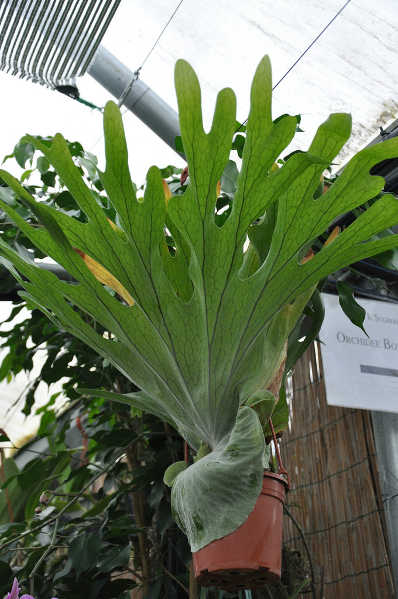
Staghorn Fern Propagation
To propagate from spores, look underneath the fertile, antler-like leaves for patches which have darkened and turned brown. Cut a leaf with a spore patch off if it’s easier to work with. Place a piece of paper underneath the leaf. Use a butter knife to scrape the underside of the leaf and release the spores onto the paper.
Once you have your spores, prepare a container for them. Use a sterilized seed starting tray with draining holes and a lid, or a heavier plastic container with no drainage. Fill it with a peat-based potting medium. Tamp the spores into the soil and moisten them lightly with a spray bottle. Keep the soil moist, and within 3 to 6 months you’ll have new ferns. Transplant staghorn ferns when they have 2 true leaves.
To propagate from pups or division of a parent plant, examine your parent plant. Look for young staghorn ferns developing along the sides or between individual plants. This is where you can make cuts to separate them. Cut very large staghorn ferns in half and separate them into two individual mature plants to reduce their size. It’s easier to simply separate all the offshoots from a mature staghorn.
Leave at least three inches of space around each plant’s base to ensure you have the whole rhizome and some base material. Use a clean saw and cut off the offshoots or mature plants, leaving as much room for mounting as possible. This video gives you a good idea of how the process works. It also shows you how to create a mounted staghorn fern!
You can mount to a board, or plant it in a wire basket. Select one with a sturdy hanger, capable of supporting a large plant. Divide pups regularly to keep the weight down! Line the inside of the basket with moistened sphagnum moss, or use a coconut coir basket liner. Then pack the interior firmly with extremely well-draining potting mix or more peat to make a base for your fern.
Place the fern into the basket where you want it to sit, and secure wires to the sides of the basket, forming an X shape that surrounds the base so it’s held in place. You may wish to run one wire across the top of the fern’s base, hiding it within the leaves. Pack more moss around the basket to hide the support wires and hang it up.
You can plant in a normal pot, although you might need to put it on a stand as the plant grows and lengthens its fertile fronds. Create a potting soil using a blend of half cactus or succulent potting blend and half orchid bark. Gently spread out the root ball if it’s visible. Then set it on top of this blend, ensuring it’s balanced and that the root ball has contact with the potting mix. Leave a little space in the pot to allow for the plant to sit down inside for extra support.
Pruning Staghorn Ferns
Staghorn ferns don’t require much pruning, but when there is any to be done, only prune the fertile fronds. If there are damaged fertile fronds, use a clean pair of scissors or pruners to cut off the frond. If the whole frond is showing signs of damage, cut it at its base. Otherwise, only remove the damaged portion.
The shield fronds or fertile fronds should be left on the plant even if they are damaged. These decompose around the plant and provide its required nutrition. Also, they protect the plant from damage, and provide extra support!
Troubleshooting
Staghorn ferns are pretty problem-free, and staghorn fern care is easy! However, there are a couple pests to be aware of, and one common disease.
Staghorn Fern Growing Problems
Realistically, you shouldn’t have many growing problems provided that you don’t overwater or underwater. If the tips of your antler fronds begin to brown, your fern is underwatered, and you should increase the frequency of your watering. If the bases of the antler fronds begin to blacken, you’re overwatering, and need to cut back the frequency.
Pests
As with almost any plant that has fleshy, moisture-holding leaves, aphids can become a problem during staghorn fern care. Scale insects like mealybugs are also a hazard. These pests suck the sap out of your staghorn ferns, leaving spotty damage behind. Staghorn ferns produce spores on their lower leaves, so don’t blast your plant with water to try to hose these pests off. Instead, opt for a gentle spraying of all plant surfaces with insecticidal soap, which will wipe them out.
Diseases
Like roses and many other thick-leaved plants, staghorn ferns are susceptible to a fungal issue called black leaf spot, also known as rhizoctonia. Root rot is also an issue. These fungi also produce spores that rapidly spread around your garden if left unchecked. If you come across either during staghorn fern care, use a double-headed approach to combatting this issue. Trim out and destroy diseased portions of the leaves, and spray down the plant with a mild fungicide.
Frequently Asked Questions
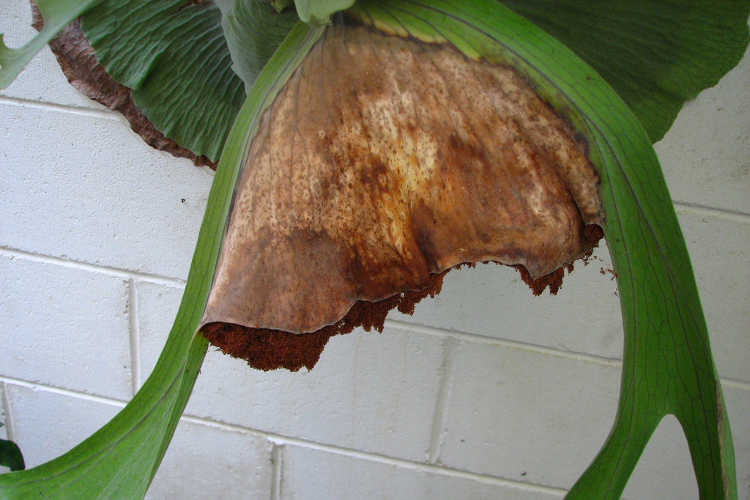
Q: Why is my staghorn fern turning brown?
A: Brown shield fronds are a normal part of staghorn fern care, but if the tips of your antler fronds brown, your fern is underwatered. If the bases of the antler fronds begin to blacken, you’re overwatering. Some pests can cause leaf browning too. Remember not to cut off a brown shield frond.
Q: Can I feed bananas to my staghorn fern?
A: This can work, but attracts insects. Instead take a little bit of compost and tuck that under or around the basal fronds. Be careful not to use too much, as you don’t want to create a pocket holds lots of water!
Q: Can you give me information on the elkhorn spore caterpillar?
A: The elkhorn spore caterpillar is a problem only in parts of Australia and New Zealand. Its scientific name is Calicotis crucifera. I recommend a general all-purpose caterpillar killer such as Bacillus thurigiensis, or BT for short applied to your elkhorn ferns.
Q: Do staghorn ferns like shade or sun?
A: While some can handle full sun, most appreciate bright indirect light.
Q: What is special about staghorn fern?
A: Its two kinds of leaves (shield frond, and basal frond) make it stand out among other epiphytic ferns.
Q: Can a staghorn fern live indoors?
A: Yes! Most staghorn ferns thrive in indoor conditions.
Q: Where is the best place to hang a staghorn?
A: Find a spot with bright, indirect light, and where it can access a daily misting of water.
Q: Can staghorn ferns grow in pots?
A: As long as staghorn ferns have the appropriate growing media, they can grow in pots.

